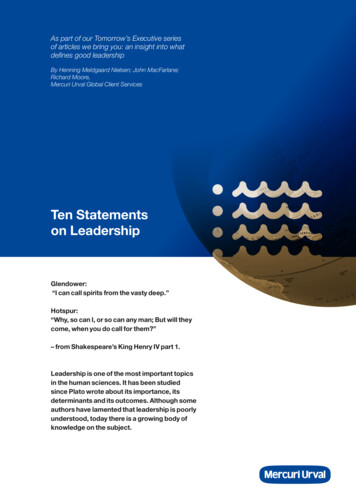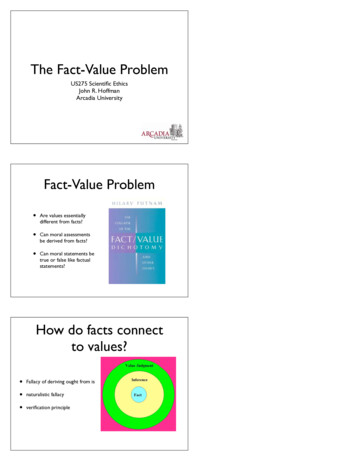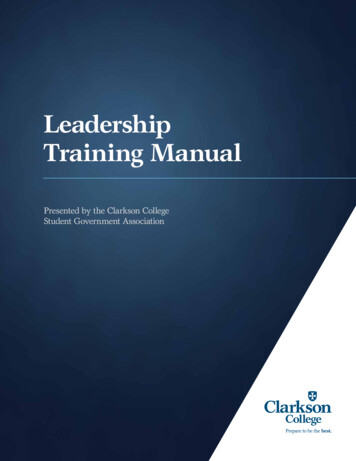
Transcription
As part of our Tomorrow’s Executive seriesof articles we bring you: an insight into whatdefines good leadershipBy Henning Meldgaard Nielsen; John MacFarlane;Richard Moore,Mercuri Urval Global Client ServicesTen Statementson LeadershipGlendower:“I can call spirits from the vasty deep.”Hotspur:“Why, so can I, or so can any man; But will theycome, when you do call for them?”– from Shakespeare’s King Henry IV part 1.Leadership is one of the most important topicsin the human sciences. It has been studiedsince Plato wrote about its importance, itsdeterminants and its outcomes. Although someauthors have lamented that leadership is poorlyunderstood, today there is a growing body ofknowledge on the subject.
The following ten statements show how Mercuri Urval defines, conceptualises andunderstands leadership. We do not pretend to know all the answers to questionsabout leadership. But we do have clear convictions based on our extensive experience and research 1. Leadership mattersWith good leadership, employee wellbeing and performance are enhanced,and consequently, organisations thrive andprosper. Research has proven time andagain that leadership is a critical determinant of organisational effectiveness, as thefollowing facts indicate:Furthermore studies on management derailment show that 65 – 75% of employeesin any given organisation report that theworst aspect of their job is their immediateboss. This causes employee engagementand performance to deteriorate (Hogan &Kaiser, 2005). In spite of the fact that we live in a knowledge economy, there is nonetheless a mismatch between what science knows andwhat business does. recent study shows that CEO turnAover affects a firm’s performance(Khurana & Nohria, 2000) Performance is approximately 20%higher and satisfaction 50% higher forsubordinates who enjoy better qualityrelationships with their supervisors, according to one study (Uhl-Bien, 2003) In a comprehensive study of 732 manufacturing firms in the US, UK, Franceand Germany “management practicesare significantly associated with higherproductivity, profitability, Tobin’s Q*,sales growth and firm-survival rates”(Bloom & Van Reenen, 2007)*Organisations should still look carefully atwhether they invest enough, in the rightway, in building there current and futureleadership capability. The ratio between a businesses market value and the replacement value of its book equity (assets).Ten Statements on Leadership
2. Leadership is defined by resultsThere are many definitions of leadership,and no single definition is right. Thereforeone has to choose which definition touse. We believe a results-based definition of leadership is the best. This meansthat the essence of leadership is buildingand maintaining a team, and guiding thatteam towards desired results. Leadershipis about achieving desired results (Hogan& Kaiser, 2005; Ulrich et al., 1999). Or asRidderstråle & Wilcox note: “Deliver exceptional output – or you become an output”(Ridderstråle & Wilcox, 2008).Dave Ulrich has made a strong case forthe need to align desired results withstrategy, and to balance them across thekey stakeholders (employees, organisation, customers and owners). To achieveresults, leaders must create value in eachof these areas. Serving only employees, forexample, yields engaged employees, butorganisations that fail to serve customersor to meet investor goals will not be successful (Ulrich et al., 1999).Overall this value creation can be seen infour areas: forming strategy, implementingstrategy, managing operations and stakeholder leadership. In each of these areasleadership must deliver results in order tobe successful.3. Leadership effectiveness should focuson group performanceIn line with this results-based approach,leadership does not primarily concern individuals, called leaders. Rather leadership isprimarily concerned with the performanceof the collective for which the leader is responsible.So an evaluation of leadership effectiveness should focus on the performance ofthe group or organisation and the leaderscontribution to that performance, not simply – as is often the case – on leader emergence or how the individual leader is re-Ten Statements on Leadershipgarded (Drucker, 2000; Kaiser et al, 2008).This distinction is important because thefactors associated with leading a successful team or organisation are not necessarilythe same as those associated with havinga successful career in management. Howa team performs and how its leaders areperceived are two different things (Kaiseret al., 2008).One study claims that measures of teamperformance and measures of career success are unrelated. Less than 10% of a
sample of general managers had botheffective teams and successful careers(Luthans, 1998)1. In an ideal world careersuccess and leadership capability wouldgo hand in hand. However, we live in thereal world.4. Leadership is a collective phenomenonLeadership implies a following. If there areno followers, there are no leaders and viceversa (Locke, 2003). Leaders have to getother people to follow them. RememberHotspur’s question: “Will they come, whenyou do call for them?”they were volunteers. As Peter Drucker hassaid; “They are paid to be sure. But knowledge workers have mobility. They canleave One does not “manage” people.The task is to lead people” (Drucker, 1999).Leadership is a relationship-based concept. Leaders act with followers ratherthan on them. Today, work gets done in anenvironment where an increasing numberof employees have to be managed as if1S uccessful managers spent their time differently than did effective managers. Career success was associatedwith socialising, politicking and networking. Effective team leadership was associated with communicating, motivating, conflict solving (Luthans, 1988). Kaiser et al. identify two categories of leadership measures, each withtwo subcategories. The first category focuses on individual leaders: a) emergence (“standing out in a crowd”) andb) perceived effectiveness (“approval”). The second focuses on the effects leaders have on the performance ofthe team: a) process (“how did the team play?”) and b) outcomes (“did the team win or lose”?) (Kaiser et al. 2008).Ten Statements on Leadership
5. Leadership is a behaviour, not aformal roleLeadership occurs when individuals useinfluence to create change. Anyone mayact as a leader (not just those in formalmanagerial roles) when they demonstrateleadership behaviours. Placing a person ina management position does not turn thatperson into a leader. There are people inmanagement positions who do not behaveas leaders. And there are people who arenot in management positions, who nonetheless demonstrate leadership qualities(Hogan, 2005; Locke, 2003; Uhl-Bien,2003).6. Leadership behaviour consists ofenvisioning, engaging and executingIn line with what has been labelled “the NewLeadership” (Bryman, 1992), to demonstrate leadership behaviour is to: decidewhat needs to be done; create networksof people and relationships that can accomplish an agenda; and ensure that thosepeople actually do the job (Kotter, 2001).In short, leadership behaviour means to:envision, engage, execute (Ridderstråle &Wilcox, 2008).The three dimensions, envision, engageand execute are invariable; the combination of these dimensions forms genuineleadership behaviour, as illustrated onthe right.Leadership means influencing othersby setting a direction for collective effort, and aligning people and mobilisingcommitment, and shaping and develop-Ten Statements on Leadershiping the collective activities in accordancewith this direction to make things happen(Locke, 2003, Zaccaro, 2007).EnvisionDecide whatneeds to bedoneEngageCreate networksof people andrelationships that canaccomplish an agendaExecuteEnsuring thatthose peopleActually do the job
Envisioning is itself an intellectual exercise.To envision and engage and execute is todemonstrate leadership.Work today gets done in an environmentwhere the indirect levers of influence are ofgreat importance – and perhaps of greaterimportance than the direct exercise ofpower (giving instructions or making decisions personally). Indirect influence canbe defined as shaping the context, so thatteam members can independently makegood decisions, take appropriate action,and behave in a desired manner. The keyto the leader’s job is not what he or shedoes personally, but what he or she getsdone with others in the organisation (Porter& Nohria, 2010). Almost a century ago,the leadership pioneer Mary Parker Follettsaid that leadership is not defined by theexercise of power, but by the capabilityto increase the sense of power amongstthose being led.7. Leadership is a function of specificleader capabilitiesWho we are determines whether we lead,and if we do, how we do it. Some peoplehave the capabilities2 to envision, engageand execute, and they will in all probabilitydemonstrate leadership. Other people donot have these capabilities and will not beable to demonstrate leadership (Hogan& Kaiser, 2005; Judge et al., 2002). AsKirkpatrick & Locke put it: “Leaders are notlike other people They do need to have“the right stuff” and this stuff is not equallypresent in all people” (Kirkpatrick & Locke,1991).2Furthermore, a large study of leadership in62 societies showed that the characteristics associated with an effective leader andwith effective leadership are to some extentsimilar across cultures (House, 2004). Inthis sense a leader is a leader is a leader(Hogan, 2007).T he term capability is used frequently in leadership literature (Uhl-Bien, 2003, p. 133, Ulrich et. al., 1999, p. 3;Zaccaro, 2007, p. 13).Ten Statements on Leadership
8. Leadership capabilities consist of skills,motivation and personality traitsLeadership capabilities – or having “theright stuff” – are certain skills, motives 3,cognitive abilities and personality traits 4,with each contributing to the influence ofthe other (Antonakis, 2011; Zaccaro et al.,2004).Leadership represents complex patternsof behaviour as illustrated in statement sixabove. Therefore leadership is explained bymultiple capabilities.Some of these leadership capabilities –like intelligence and personality – have astrong hereditary and genetic basis (Arvey& Chaturvedi, 2011). They are hardwiredinto our DNA, and are relatively fixed overtime. he genetic basis is documented inTstudies of twins. Identical twins, whoshare all their genes, resemble eachother much more than fraternal twinsdo, whether or not they are raised in thesame family. About half of the observedvariation in trait scores appears to begenetically based (McCrae & Costa,2008). rait stability is documented in longiTtudinal studies in which personality isassessed twice, many years apart (McCrae & Costa, 2008).Other leadership capabilities are less fixedand can be developed through work, educational experiences and training (Avolio &Vogelgesang, 2011). For example, a recentstudy showed that charisma can be taught(Antonakis, In press).The common question regarding whetherleaders are born or made can be answered: Yes! And, we can add, that it is theinteraction between genetics and environments that explain human development(Chaturvedi et al., 2011).We can see the relationship between capability, behaviour and results in more detailas shown on the following page:A ccording to Chan & Drasgow there are three components of the motivation to lead: a) affective, where individualsenjoy the emotions that are part of the leadership experience, b) social-normative, where individuals take on leadership roles because of a sense of duty or need and c) non-calculative, where individuals do not think about thesacrifice that the leadership role may require and thus do not think to avoid leadership roles for this reason (Chan &Drasgow, 2001). This motivation to lead may be coupled with a need for achievement.4 Personality traits are individual characteristics that a) are measurable, b) vary across individuals, c) exhibit temporaland situational stability and d) predict attitudes, decisions or behaviours and consequently outcomes (Antonakis,2011). The Five-Factor Model (often called the “Big 5”) is today the most widely-accepted solution to the problemof describing trait structure. Just as anywhere on earth can be specified by the three dimensions of latitude,longitude and altitude, so anyone’s personality can be characterised in terms of the five dimensions of the FFM:conscientiousness (C), extroversion (E), openness (O), agreeableness (A) and emotional stability, neuroticism (N),(McCrae & Costa, 2008).3Ten Statements on Leadership
BehaviourBehaviours that lead to success in a roleKnowledgeSkillsExperienceCapabilities acquired through learning and practiceCognitiveAbilityPersonalityValues, Normsand AttitudesInterests andMotivationQualities determining how skills, knowledge and experience are acquiredand applied in a role9. Leader capabilities can be measured, andleader emergence, leadership behaviourand group performance can be predictedLeadership capabilities can be identifiedand measured, and can even predict whowill emerge as leaders (managerial role occupancy) and who will be effective leaders. comprehensive meta-analysis docuAments correlations between conscientiousness, extroversion, opennessand emotional stability with leadership(Judge et al., 2002). recent study measures the relationAship between personality and leadership criteria, with a twelve-year spanbetween trait predictors and leadershipcriteria, and reports a relationship be-5tween extroversion, leader emergenceand transformational leadership (Reichard et. al., 2011).Leadership capabilities can consistentlyand reliably differentiate leaders from nonleaders, and consequently can serve asa basis for leader assessment, selection,training and development (Zaccaro, 2007).Using valid leader capability models hasimportant economic as well as ethical implications (Antonakis, 2011).“If you measure personality well, it hasenduring effects on almost every aspectof work and life,” says Timothy Judge 5.A recent study documents that the FFM personality variables as a set predict job performance, leadership, workattitudes and motivation. The authors conclude: “Any theory of organisational behaviours that ignores personalityvariables would be incomplete. Any selection or decision that does not take the key personality characteristics ofjob application into account would be deficient” (Ones et al., 2007).Ten Statements on Leadership
What is more, as the work environmentbecomes less rigid, less routine and moreautonomous, personality becomes moreimportant (Stewart & Barrick, 2004).CapabilitiesOverall, the above nine statements can besummarised in the following model:BehaviourRead from left to right, the model illustrates leadership value creation: howleadership capabilities are put to purposeful work; how they are transformedinto behaviour, and how this createsdesired results. Read from right to left,the model shows how desired resultsResultsare translated into leader behavioursand required leader capabilities.It is important to stress that this, like allmodels, is a simplification. And that leadson to the last statement 10. Leadership does not take place ina vacuumIn general, behaviour is a function of personality and situation, and this goes forleadership behaviour as well. There aresituational attributes that moderate thecapability-behaviour-results relationship illustrated above. In some situations capabilities are not transformed into behaviour,and in other situations, behaviour does notcreate results.Some organisational structures and socialarrangements will facilitate human performance and foster leadership. Other suchTen Statements on Leadershipstructures and arrangements will degradehuman performance and hinder leadership.The kind of organisation, culture and context in which leaders function, the relationship between leader and superiors, subordinates, external constituencies, peers andthe kind of product or service provided bythe organisation – are all situational attributes that matter.
In Summary:1. Leadership matters – it affects thevalue and performance of organisations9. L eadership ability can be measured– and therefore predicted and developed2. Leadership is defined by results –there is no “right” approach, but thereare “right results”10. Leadership does not happen in avacuum – the environment is relevantto performance3. Leadership is about groups – its effect on the performance of a collectiveThis means that leadership selection anddevelopment:4. Leadership requires followers – andfollowers choose to follow, or not Must be driven by insight into behaviour an focus on general capabilities,Cbuilding on strengths and mitigating forweaknesses6. Leadership is envisioning, engagingand executing eeds to happen in the individual’s curNrent context or future situation7. L eadership is a function of a person’s capabilities – personal qualitiesand specific competencies hould be focused on changing behavSiour to improve results I s about improving the performance ofteams as well as leaders5. Leadership is a behaviour – it is not aformal role8. L eaders are both born and made –some capabilities are inherited (emerging over time) and others are learnedthrough experienceBiosHenning Meldgaard Nielsen works as adirector and consultant in Mercuri Urval.He has a Master degree in Political Science from the University of Aarhus. He hasworked for Mercuri Urval for 18 years. Hennings primary field of interest is how to promote a results-based, evidence-based andstrengths-based approach to leadership.Ten Statements on LeadershipJohn Macfarlane is Chief Psychologist ofMercuri Urval Denmark. He has a Mastersdegree in Psychology from the Universityof Copenhagen. He has worked at Appleas Director of Human Resources and hasbeen with Mercuri Urval since 1991. Formore than 30 years he has worked withmanagers and leaders of both public andprivate organisations to advance the causeof ever better leadership.
Richard Moore leads Mercuri Urval’s GlobalClient Services team. He has a Bachelordegree in History from Lancaster University. He has worked for Mercuri Urval for11 years. His team ensures that MercuriUrval has the right people, solutions andapproaches in place for our global clients,wherever and whenever they need them.About Mercuri UrvalOver 40 years ago, Mercuri Urval wasfounded to help answer a simple but important question:How do organisations make sure theyhave the right people, so they candeliver the best possible business results?As pioneers in predicting the impact of people’s capabilities and personality on business results, we have always placed highimportance on the recruitment, selectionand development of people. And that is stillthe core of our business.Today, Mercuri Urval has grown organicallyto become a leading consultancy, workingwith more than 3,000 clients in over 50countries every year. As we have grown,our services have expanded to include arange of Board and Executive, Talent Management and Business Transformation solutions, built to meet our clients’ needs tostrengthen their people’s performance.Over the coming months, further articlesin this series will be published, developingin more detail how tomorrow’s successfulexecutive will need to lead.Send Mercuri Urval your comments .comReferencesAntonakis (2011). Predictors of Leadership: The Usual Suspects and the Suspect Traits. Bryman et al. (Ed.). The SageHandbook of Leadership. L.A.: Sage Publications.Antonakis et al. (In press). Can charisma be taught? Tests of two interventions. Academy of Managerial Learning &Education.Avolio & Vogelgesang (2011). Beginnings Matter in Genuine Leadership Development. Murphy & Reichard (Ed.). EarlyDevelopment and Leadership. Building the Next Generation of Leaders. New York: Routledge.Bloom & Van Reenen (2007). Measuring and explaining management practices across firms and countries. AIMResearch Working Paper Series.Chan & Drasgow (2001). Toward a Theory of Individual Differences and Leadership: Understanding Motivation toLead. Journal of Applied Psychology. Vol. 86 (3). Pp. 481-498.Chaturvedi et al. (2011). The heritability of emergent leadership: Age and gender as moderating factors. The Leadership Quarterly. Article in press.Conger, Jay A (1998). The Necessary Art of Persuasion. Harvard Business Review, Reprint 98304.Ten Statements on Leadership
Drucker (1999). Management Challenges for the 21st Century. HarperCollins Publishers.Hackman, J. Richard (2010). What is the thing called leadership? Nohria & Khurana (2010). Handbook of LeadershipTheory and Practice. Harvard Business Press. Boston, Massachusetts.Hogan (2007). Personality and the Fate of Organizations. New York: Psychology Press.Hogan & Kaiser (2005). What we know about leadership. Review of General Psychology. Vol. 9. No. 2. pp. 169-180.House et. al (2004). Culture, Leadership and Organizations. The GLOBE Study of 62 Societies. Thousand Oaks: SagePublications.Judge, Bono, Ilies & Gerhardt (2002), Personality and Leadership: A Quantitative Review, Journal of Applied Psychology, 2002, vol. 87, No. 4, 765-780.Kaiser et al. (2008). Leadership and the Fate of Organizations. American Psychologist. Vol. 63, No. 2, pp. 96-110.Kaiser & Overfield (2010). The Leadership Value Chain. The Psychologist-Manager Journal. Vol. 13, pp. 164-183.Kirkpatrick & Locke (1991). Leadership: do traits matter? Academy of Management Executive, 1991, vol. 5, no. 2.Khurana & Nohria (2000). The Performance Consequences of CEO Turnover. Available at SSNR http://papers.ssrn.com/sol3/papers.cfm?abstract id 219129Kotter (2001). What Leaders Really Do? Harvard Business Review on Leadership. Harvard Business School Press.Locke (2003). Foundations for a Theory of Leadership in Murphy & Riggio (Ed.). The Future of Leadership Development. New Jersey: Lawrence Erlbaum Associates.Luthans (1988). Successful vs. effective real managers. Academy of Management Executive. 2. pp. 127-132.McCrae & Costa (2008). Empirical and Theoretical Status of the Five-Factor Model of Personality Traits. In Boyle etal. (Ed.). The Sage Handbook of Personality Theory and Assessment. Vol. 1. Sage Publications Ltd.Ones et al. (2007). In support of personality assessment in organizational settings. Personal Psychology. 60, pp.995-1027.Porter & Nohria (2010). What is Leadership. The CEO’s role in Large, Complex Organizations. Nohria & Khurana(2010). Handbook of Leadership Theory and Practice. Harvard Business Press. Boston, Massachusetts.Reichard et al. (2011). A longitudinal analysis of relationships between adolescent personality and intelligence withadult leader emergence and transformational leadership. The Leadership Quarterly. Vol. 22, pp. 471-481.Ridderstråle & Wilcox (2008). Re-energizing the corporation. West Sussex: John Wiley & Sons Ltd.Stewart & Barrick (2004). Four Lessons learned from the person-situation debate: A review and research agenda.Available at http://people.tamu.edu/ mbarrick/Pubs/2003 Stewart Barrick.pdfUhl-Bien (2003). Relationship Development as a Key Ingredient for Leadership Development. Murphy & Riggio (Ed.)The Future of Leadership development. New Jersey: Lawrence Erlbaum Associates.Ulrich et al. (1999). Results-based Leadership. Boston, Massachusetts: Harvard Business School Press.Ulrich et al. (2003): The Leadership Code. Boston, Massachusetts: Harvard Business School Press.Zaccaro (2007). Trait-based Perspectives of Leadership, American Psychologist, Vol. 62, No. 1, 6-16.Zaccaro & Klimoski (2001). “The Nature of Organizational Leadership. An introduction”. I Zaccaro & Klimoski (eds).The Nature of Organizational Leadership. Jossey-Bass Inc. San Francisco.Zaccaro, Kemp & Bader (2004). “Leader Traits and Attributes” I Antonakis (ed.) (2004). The Nature of Leadership.Sage Publications.Ten Statements on Leadership
Ten Statements on Leadership There are many definitions of leadership, and no single definition is right. Therefore one has to choose which definition to use. We believe a results-based defini-tion of leadership is the best. This means that the essence of leadership is building and maintaini










